Sea Scouts (The Scout Association)
Sea Scouts are a branch of The Scout Association in the United Kingdom dedicated to boating and water-based activities such as sailing, canoeing, motorboating and water navigation. The branch were first formed in 1909 with specialist Sea Scout troops and have been a feature of the wider Scouting movement ever since.[1] They are usually based by the side of water, either the sea, lake, river or canal.[2]
| Sea Scouts | |||
|---|---|---|---|
 The Logo of the Sea Scout branch. | |||
| Owner | The Scout Association | ||
| Age range | 10½–14 | ||
| Headquarters | Gilwell Park | ||
| Country | United Kingdom | ||
| Founded | July 1909 | ||
| Founder | Warington Baden-Powell | ||
| |||
| Website http://scouts.org.uk/scouts | |||
Sea Scouts may be organised as Sea Scout Groups, where there is a nautical focus for all sections offered by the group, or as individual Sea Scout troops within a larger group that may not share the same nautical focus. Younger members of a Sea Scout group, in the Beaver Scout (6-8 years of age) and Cub Scout (8-10½ years of age) sections, follow the same programme and wear the same uniform as those in 'Land Scouts'. However members in Sea Scout troops (10½-14 years of age) and Sea Explorer units (14-18 years of age) wear a different uniform and follow a more nautical focus within the current Scout programme. With the exception of Air Scouts, they are the only part of the movement that wears hats as part of their official uniform.
History
Foundation
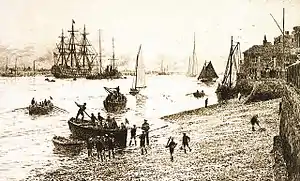
Similar to their land based counterparts, the start date of Sea Scouts is difficult to define and has during the history of the branch been defined either as the first Sea Scout camp in August 1909 or the date when they were first officially recognised as a branch of the Scouts in October 1910. By the mid-20th Century this latter date was considered the anniversary of the section with the 50th anniversary being celebrated in 1960 however in the 21st century the earlier date has been used to match the similar earlier date of the 'land' branch (which considers itself founded in 1907 at the Brownsea Island camp) with the centenary of the Sea Scout branch celebrated in 2009.[3]
Regardless of this initial date, water based activities had been a part of the movement from the earliest years. Scouting's founder Robert Baden-Powell wrote in Scouting for Boys (published 1908) that 'a Scout should be able to manage a boat, to bring it properly alongside a ship or pier.'[2] In February 1909 The Scout reported on the foundation of a new branch of Scouts around Glasgow who were referring to themselves as Sea Scouts stating they will be just the same as Land Scouts but trained 'on a naval basis, learning naval drills and visiting His Majesty's ships whenever possible.'[2] In June of 1909 a Seamanship badge was introduced that allowed those who achieved it to be recognised as a Sea Scout in rank.[2][4]
The first camp took place in July to August 1909 on the ship TS Mercury, moored at Buckler's Hard, with 50 spent sleeping on the ship and another 50 spent camping on the shore before swapping after a week. The 100 places were allocated through a competition in the Scout magazine. Henry Warrington Smyth Baden-Powell, older brother of Robert, founded the branch and in 1912 would write the comprehensive manual Sea Scouting and Seamanship for Boys, a follow-up to the short booklet Sea Scouting for Boys published the previous year by his younger brother.[3][4][5]
Leysdown disaster
Very early on in the history of Sea Scouts, the branch was hit by two accidents which resulted in the loss of life of several Sea Scouts. The most prominent was the Leysdown disaster of 4th August 1912 when an ex-naval cutter carrying 23 Sea Scouts from Walworth, London, off the coast of Leysdown-on-Sea, Isle of Sheppey, capsized in a sudden storm. Despite the efforts of five coastguards and two civilians, nine of the Scouts drowned. A mass funeral was held on 10 August attended by thousands including Scouts from several countries.[2][4]
That same year the Sea Scouts of London were presented a 52 ton ketch yacht by the Daily Mirror newspaper and named Mirror. However just the following year the boat was struck by another vessel resulting the loss of four lives.[3] [2]
Following both these tragedies new rules were put in place and training tightened but these did not deter the progress of the branch. In early 1914, the HQ Gazette announced that 'No boat training shall be undertaken unless the Scout can swim fifty yards' and the August 1914 published Seamanship for Scouts by Lt Cdr W. H. Stuart Garnett had a greater emphasis on safety management.[4]
Service in World Wars
Just five years to the month after the start of the Sea Scout branch World War I broke out and Scouts across the country found themselves becoming involved on the home front with non-militarised service. While Scouts in general took on roles guarding bridges, telegraph lines or culverts from damage and acting as messengers, Sea Scouts in particular took up a role across the country supporting the coast guard.[6] With the Royal Navy on a war footing, Baden-Powell thought that getting scouts to watch estuaries, ports and from coastguard stations this could free up men needed for military service.[5] The scouts were supervised by the coastguard but were under the orders of the Patrol Leaders and many were already trained for the roles, a Coast Watcher badge having been introduced in 1911 to Admiralty standards.[5] The call was a success with 1,300 Scouts on coast watching duty within two months of the war's outbreak[5] and 23,000 Scouts having been coast watchers during the course of the war.[6] Specific duties included patrolling the beaches, salvaging wreckage, watching for fishing boats working unauthorised at night, examine boats coming into shore checking permits, answering naval calls on the telephone and report vessels passing up and down the coast.[7] Following the efforts of the Scouts and Sea Scouts in World War I, in 1919 Sea Scout groups were able to gain Royal Navy recognition for the first time.[8]
Just 20 years after being recognised for their work in the first world war, the Scouts found themselves once again helping in the war effort for the second. Sea Scouts proved able telephone operators, signallers, stretcher bearers to the Thames River Emergency Service and once again did coast watching and acted as signallers for the Coastguard and Royal Navy.[3] Notably, the 1st Mortlake Sea Scouts took their motor picket-boat Minotaur to France as part of the Dunkirk evacuation in 1940.[9] With bombing of towns and cities across Britain as part of the Blitz, Scouts also took on roles helping during the air-raid; George Collins, a Patrol Leader with the 12th Shoreditch Sea Scouts was awarded a Silver Cross for bravery when he rescued three children from a house in Barnet during bombing on 8 October 1940.[9]
The contribution of Scouts in the Second World War was much less recognised than their work in the First and so in 1943 a leaflet was published to promote Sea Scouting which included details on how to join and what activities were completed and the following year a Sea Scout Exhibition took place from 10–19 April at the Scottish Drill Hall and attended by Princess Elizabeth.[3]
Inter-war years
Between the two World Wars where the section become known for their service, other developments in the branch were made. In 1928 a new branch of Sea Scouts, the Deep Sea Scouts, was formed to enable young people who had begun a working life aboard ships to maintain contact with the Scout movement.[10][11]
With the growth of the section also demanded a growth in capacity for training. The Sea Scouts still has access to TS Mercury but in 1936 the RRS Discovery, the ship that had taken Robert Falcon Scott to the South Pole, was offered to the movement and was promptly bought in January 1937 following a donation from Lucy, Lady Houston.[3][12]
Post-war years
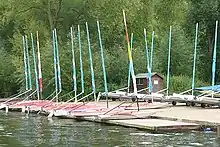
In 1947 Viscount Mountbatten of Burma was made Commodore for Sea Scouts. The Sea Scouts were very prominent immediately after the war taking part in a number of events: almost 400 Sea Scouts attended the 6th World Scout Jamboree in France with a number maintaining a flag on Sea Scout island and camping there to ensure its integrity.[3] Sea Scouts were also involved in the 1948 Summer Olympics with 200 helping to ferry competitors between boats and jetties near the sailing events in Torbay.[13]
In August 1950 the Sea Scouts faced another tragedy when the Wangle III, a whaler owned by the 1st Mortlake Sea Scouts, was lost and all ten Sea Scouts on board drowned.[8] The post-war period also saw the retiring of a number of training vessels used by the Scouts: the RRS Discovery was transferred back to Royal Navy ownership in 1954 when the Scouts could no longer afford the upkeep and is now in the ownership of a maritime trust and can be found in Dundee[3] and in 1968 the TS Mercury was retired[3] and is currently at Chatham Historic Dockyard and is being restored as its previous persona of HMS Gannet.[14] To compensate, in 1956, Marlow, Buckinghamshire on the River Thames became home to Longridge Scout Boating Centre to train in seamanship and other water sports with training equipment transferred from RRS Discovery.[3]
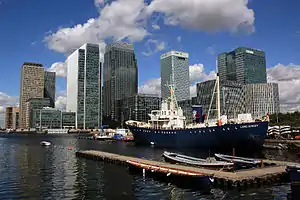
Further provision came following the permanent relocation of the RRS Discovery to Dundee in 1979 when the Dockland Scout Project was formed as a new London base for Sea Scout training. Compared to the previous base on the Victoria Embankment this was based in West India Docks in the developing London Docklands. This has developed from a wooden pavilion, derelict warehouse and a small fleet of dinghy boats in the area now occupied by Canary Wharf to a metal cutter the Lord Amory and a new boathouse complex acquired in 1981 and 1994 respectively. These are used as a base for water activity weekends for Scouts, Sea Scouts, Guides, Sea Cadets, Air Cadets and Sea Rangers among others and has received support over time from the Port of London Authority, the London Docklands Development Corporation, British Waterways and the Canal and River Trust.[3][15][16]
Centenary
The centenary of Sea Scouting was celebrated in 2009. The Centenary Sea Scout Jamboree was held in August of that year, at the Holme Pierrepont National Watersports Centre in Nottinghamshire. Around 3,000 Sea Scouts participated in the event and came from around the world featuring both land and sea activities.[17][18][19]
The centenary of Royal Naval recognition in 2019 was also celebrated by the Scouts with an occasional badge that could be worn on uniforms being released.[20]
Organisation
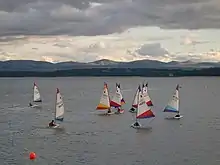
As a branch of the Scout Association, Sea Scouts and Explorer Sea Scouts share much of the organisational structure of their sister sections. Members of both make the same promise as any other Scout or Explorer Scout and take part in the same wider programme based on the themes of Outdoor and Adventure, World and Skills, although the nautical elements of this programme tend to be the focus of activities especially in the summer months when the weather is fine enough for boating outdoors. Approaches vary but some sections put on additional meetings for boating skills while others use their regular meetings to focus on these skills during those times. The sections are led by volunteer leaders as part of a team made up of uniformed leaders, assistant leaders and more informal sectional assistants and parent helpers. Due to the technical nature of the boating and the specialised instruction required, Sea Scout groups and sections may have more skills instructors than other groups and sections to enable the water-based programme to occur.[8][20]
The Sea Scout section is run at a local level by Scout Groups which may nor may not specialise as a Sea Scout group. They are led locally by a volunteer manager, called a Group Scout Leader, and are responsible for ensuring the standards of the section are maintained. It is usual for the Sea Scout section to be divided into patrols of young people led by a Patrol Leader, usually a more experienced member of the section.[20][21]
Royal Navy Recognition
.png.webp)
In the United Kingdom there are approximately 400 Sea Scout Groups and up to 101 of these are recognised by the Royal Navy.[8] The scheme began in 1919 following the efforts of Scouts during World War I in support of the armed forces, through service as coast watchers, first aiders, fire fighters and messengers.[8] Groups that apply for Recognition are inspected by a Royal Navy officer and, providing there is a vacant position, Groups that pass the inspection and meet the standards of the Royal Navy are awarded recognition on behalf of the Admiralty Board.[8]
Recognised Groups are entitled to fly a Red Ensign[22] and blue pennant, both defaced with a Scout arrowhead and Admiralty crown. Members may also wear the Royal Navy Recognition badge on uniform.[23] Sea Scouts may go to sea with the Royal Navy, visit military establishments and use facilities at HMS Excellent, such as the Royal Navy Sailing Centre and the Youth Training Ship, HMS Bristol. Three events occur annually for Royal Navy Recognised Sea Scouts, a swimming gala at HMS Raleigh, a football competition at HMS Excellent, and a summer "camp" aboard HMS Bristol. Another camp is held for Sea Explorers in October of each year.[24]
Visual identity
Uniform
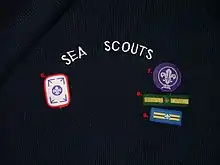
The uniform for Sea Scout troops is a mix of naval and Scout styles. Members of a Beaver Scout colony or Cub Scout pack in a Sea Scout Group do not wear a special uniform and instead wear the uniform common to all members of the section.
The uniform for Sea Scouts consists of a light blue long sleeve shirt or blouse or dark blue jersey, smart navy blue trousers or skirt, a leather scout belt and buckle, Scout Group scarf and a Seaman's Class 2 round cap with 'Sea Scout' on the tallyband.[25] Groups may optionally also choose to adopt navy blue shorts, activity trousers or outer jacket, grey fleece or white lanyard with bosun's call as part of their official uniform.[25] A navy blue sweatshirt and baseball cap are optionally available for activity wear.[25]
The uniform for leaders in a Sea Scout group is similar however leaders are not permitted to wear the blue jersey, have the option of a navy blue tie as a formal option for their uniform and wear different caps. Instead of the Class 2 cap, leaders wear a peaked officer hat with a white top and a Sea Scout cap badge with an option for female leaders of wearing a naval pattern tricorn hat.[26]
Flag
In addition to any flags that may be flown as part of normal identification purposes, Sea Scout troops will also have a flag that identifies their section for use in parades and when investing a new member to the troop. Sea Scout troop flags are the same size as other Scout flags (4ft by 3ft) and are navy blue with the name of the group name and location in white lettering around a white Scout arrowhead on a purple circle in the centre of the flag.[22][27]
Logo
Since 2009, the Sea Scout branch does not use a specific logo of their own, instead using a version of the main Scout Association corporate logo with Sea Scouts placed underneath. Their message is the same as the other sections in Scouting, focusing between 2009 and 2018 on Everyday Adventure, and since 2018 on Skills for Life with appropriate images to show this. The section uses the blue colour palette more than other sections and today may use Navy blue for publications more than the Scout purple used by others.[28][29]
Explorer Sea Scouts
| Explorer Sea Scouts | |||
|---|---|---|---|
 Logo for the section. | |||
| Owner | The Scout Association | ||
| Age range | 14–18 | ||
| Headquarters | Gilwell Park | ||
| Country | United Kingdom | ||
| Founded | February 2002 | ||
| |||
| Website http://scouts.org.uk/explorers | |||
Explorer Sea Scouts are the section for 14-18 year olds that follow the Sea Scouting approach to Scouting within the Scout programme. They are able to complete the same activities and badges as other Explorer Scouts but often have a nautical themed programme.
Organisation
A Sea Explorer Scout section is run at a higher level than a Sea Scout troop, being run by Scout Districts which run a number of Explorer Scout units. Individual units are led by a volunteer leadership team, as with other younger sections, and are supported by a volunteer manager at district level, the District Explorer Scout Commissioner. Explorer Scout Units in general may form links with a particular group through the forming of a partnership agreement and indeed many Sea Explorer Scout Units are partnered to groups that have Sea Scout troops or are Sea Scout groups as a whole.[30]
Uniform
The uniform for Explorer Sea Scouts consists of a light blue long sleeve shirt or blouse, smart navy blue trousers or skirt, a leather scout belt and buckle (or the Explorer Belt or Young Leader belt if achieved), unit scarf or navy blue tie and a Seaman's Class 2 round cap with 'Explorer Sea Scout' on the tallyband or a peaked officer hat with a white top and a Sea Scout cap badge depending on the choice of the Explorer Scout unit.[31] Units may choose to adopt navy blue shorts, activity trousers or outer jacket or a grey fleece as part of their official uniform.[31] A navy blue sweatshirt and baseball cap are optionally available for activity wear.[31]
The uniform for leaders is very similar however leaders must wear the peaked officer hat although female leaders have a choice of wearing a naval pattern tricorn hat.[26]
Flags
Similar to Sea Scout troops, Explorer Sea Scouts use a flag that identifies their section for use in parades and when investing a new member to the troop. The design is exactly the same as that of Sea Scout troops being a 4ft by 3ft navy blue flag with the name of the group name and location in white lettering around a white Scout arrowhead on a purple circle in the centre of the flag.[22]
Deep Sea Scouts
The Deep Sea Scouts (DSS) is a National Scout Active Support Unit of The Scout Association with the aim of connecting Scouting to the sea.[32] It was originally formed in 1928 as a branch of Sea Scouting that enabled young people serving on British ships to participate in Scouting activities. The decline in British shipping numbers, both naval and merchant, in the late 20th century was reflected in a reduction in membership of the Deep Sea Scouts. Following a review, control transferred from the Programme and Training Department to became a National Scout Fellowship in 1991 and was known as the Deep Sea Scout Fellowship. A subsequent national review of Scout Fellowships resulted in the creation of Scout Active Support, and the fellowship was renamed back to Deep Sea Scouts in 2010.[10]
See also
- Royal Navy Recognised Sea Scouts
- Sea Scout
- RRS Discovery — the ship of Scott's first expedition to the Antarctic, later used as a Sea Scout training ship
- TS Mercury - Ship used as a training ship by the Scouts.
- The Scout Association - The parent organisation of the section.
- Age Groups in Scouting and Guiding
- Scouts (The Scout Association)
- Explorer Scouts (The Scout Association)
- Air Scouts (The Scout Association) - Variation based on air activities, includes Air Explorer Scouts.
References
- "The Passing Years: Milestones in the progress of Scouting" (PDF). members.scouts.org.uk. The Scout Association. August 2009. Retrieved 16 October 2020.
- Blackman, Sophie, ed. (2019). Scouts: The stories that built a movement (1 ed.). London: Studio Press. pp. 36–37. ISBN 9781787415546.
- "A History of Sea Scouting". The Scout Association Archive. The Scout Association. Retrieved 16 October 2020.
- Cohen, Susan (2012). The Scouts. Oxford: Shire Publications. pp. 16–17. ISBN 9780747811510.
- A History of Scouting in 100 Objects. London: The Scout Association. 2014. pp. 27–33.
- A History of Scouting in 100 Objects. London: The Scout Association. 2014. p. 36.
- Cohen, Susan (2012). The Scouts. Oxford: Shire Publications. p. 19. ISBN 9780747811510.
- "Scouting Afloat: Sea Scouting in the UK" (PDF). The Scout Association. November 2004. Retrieved 29 April 2014.
- Cohen, Susan (2012). The Scouts. Oxford: Shire Publications. pp. 34–35. ISBN 9780747811510.
- "History". Deep Sea Scouts. Retrieved 2016-08-11.
- Cohen, Susan (2012). The Scouts. Oxford: Shire Publications. p. 28. ISBN 9780747811510.
- A History of Scouting in 100 Objects. London: The Scout Association. 2014. p. 41.
- Cohen, Susan (2012). The Scouts. Oxford: Shire Publications. p. 39. ISBN 9780747811510.
- "REUNITED WITH TS MERCURY". Chatham Historic Dockyard. 18 September 2018. Retrieved 16 October 2020.
- "History". Lord Amory. Dockland Scout Project. Retrieved 16 October 2020.
- "Grants awarded to local charities". Canal and River Trust. Canal and River Trust. Retrieved 16 October 2020.
- "Scouts splash down for Centenary Sea Scout Jamboree". members.scouts.org.uk. The Scout Association. Retrieved 16 October 2020.
- Keogh, Kat (11 August 2009). "Sea Scouts enjoy their centenary with a jamboree week at the National Watersports Centre in Nottingham". Birmingham Live. Reach plc. Retrieved 16 October 2020.
- "Sea Scouts celebrate centenary in Notts". Nottingham Post. Northcliffe Media. 1 August 2009. Archived from the original on 30 April 2014. Retrieved 16 October 2020.
- "Introduction to Sea Scouting". members.scouts.org.uk. The Scout Association. Retrieved 16 October 2020.
- "Policy, Organisation and Rules: 3. The Scout Group: 3.9 The Scout Troop". scouts.org.uk. The Scout Association. Retrieved 16 October 2020.
- "Policy, Organisation and Rules: 12. Flags and ceremonial". scouts.org.uk. The Scout Association. Retrieved 16 October 2020.
- "Royal Navy Recognition Scheme" (PDF). members.scouts.org.uk. The Scout Association. March 2010. Retrieved 16 October 2020.
- "RN Recognition". RN Sea Scouts. The Scout Association. Retrieved 16 October 2020.
- "Policy, Organisation and Rules: 10. Uniform, badges and emblems: 10.8 Sea Scout Uniform". scouts.org.uk. The Scout Association. Retrieved 16 October 2020.
- "Policy, Organisation and Rules: 10. Uniform, badges and emblems: 10.15 Sea Scout Network / Adult Members Uniform". scouts.org.uk. The Scout Association. Retrieved 16 October 2020.
- "Sea Scout Flag (without lettering)". Scout Store. The Scout Association. Retrieved 16 October 2020.
- "SEA SCOUT BRAND IDENTITY" (PDF). scouts.org.uk/brand. The Scout Association. Archived from the original (PDF) on 30 March 2020. Retrieved 16 October 2020.
- "On board and inspired. Brand guidance for Sea Scout Groups 2018" (PDF). South London Scouts. The Scout Association. Retrieved 16 October 2020.
- "Explorer Scout Structures" (PDF). members.scouts.org.uk. The Scout Association. October 2010. Retrieved 16 October 2020.
- "Policy, Organisation and Rules: 10. Uniform, badges and emblems: 10.12 Sea Explorer Scout Uniform". scouts.org.uk. The Scout Association. Retrieved 16 October 2020.
- "Who We Are". Deep Sea Scouts. Retrieved 2016-08-11.